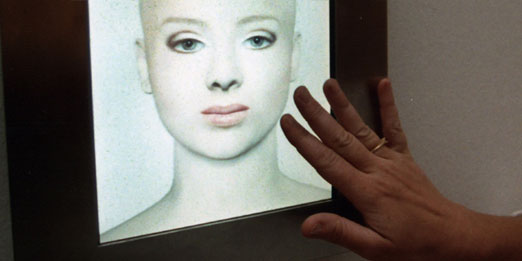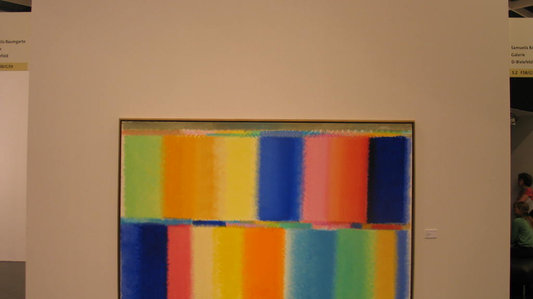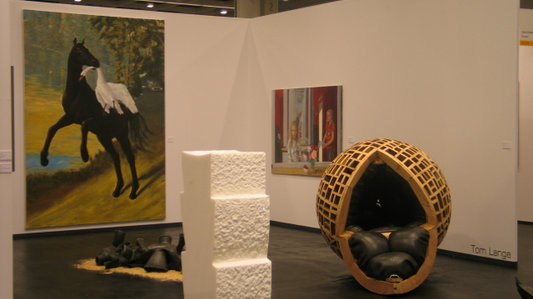Kirsten Geisler
Biografie
Kirsten Geisler wurde 1949 in Berlin geboren und studierte an der Vrije Academie im Haag von 1984 bis 1985, danach, 1985 bis 1989 an der Rietveld Academy in Amsterdam. In den Neunzigern war sie Gastdozentin an der Kunstakademie in Utrecht, Abteilung Neue Medien.
Ihr Werk benutzt die neuen Medien und verlässt sich auch auf die technischen Möglichkeiten des Computers. So entstehen Video-Skulpturen und Bildprojektionen, die die Grenze zwischen materieller Produktion und der geistiger Gegenwart ihrer Figuren verwischen.
Ihr Hauptthema sind weibliche Figuren und Gesichter, die Schönheit vermitteln sollen. Der Schönheitsbegriff ist sehr intensiv erforscht worden, ist er doch eines der „ewigen“ Ideale. Kürzlich geschah das auch unter Zuhilfenahme von Computermodellen. Lange vor der Erfindung der Computer jedoch haben Psychologen schon Fotos von Gesichtern übereinander kopiert und gelangten so zu einem ein wenig unscharfen, aber erkennbaren, verallgemeinerten Gesicht. Wenn man Menschen bat, ein Gesicht nach der Schönheit zu beurteilen, war das schönste stets das, welches dem künstlich erzeugten Gesicht am nächsten kam. Es gibt also eine der Schönheit unterliegende Tiefenstruktur, und die ist auch mit Rechnern untersucht worden. Dabei hat man genaue Daten festlegen können, etwa bezüglich der Abstände (zwischen den Augen zum Beispiel) und der Maßverhältnisse. Mit solchen Zurüstungen kann man dann Modelle schaffen, die, zumindest in Bezug auf die angewendeten Prinzipien, Schönheit besitzen.
Kirsten Geislers Frauen besitzen alle diese Schönheit, aber dennoch irritieren sie den Betrachter. Einige besitzen eine künstliche, fremdartige, metallische Anmutung, andere sehen natürlicher aus, aber selbst diese sind etwas verunsichernd, weil sie einen sehr unpersönlichen Ausdruck haben. Diese virtuellen Frauen (Kirsten Geisler nannte ihre erste virtuelle Frau „Maya Brush“) repräsentieren den Stereotyp des Weiblichen, wie er von den Medien propagiert wird, aber Kirsten Geisler definiert das als fehlgeleiteten Traum.
Geisler exposes the extent to which even our contemporary screen culture, despite its frequently seductive appeal, remains a onedirectional interface—still adhering to the logic of the Renaissance window.

Ausstellungen
Messen
Museumsausstellungen (Auswahl)
2012
Frans Hals Museum, Haarlem, Maskerade
Museum Villa Rot, Burgrieden-Rot, Jäger und Gejagte – Insekten in der Gegenwartskunst
Sala de Exposiciones Hospedería Fonseca, Salamanca, COLAPSO. UN ENSAYO SOBRE EL FRACASO Y LA RUPTURA
2011
Kumu, Kulturhauptstadt Tallinn: "gateways. Kunst und vernetzte Kultur"
2010/2011
Netherlands Media Art Institute, Amsterdam: Technology Requested
2009
Museo Nacional de Bellas Artes, Buenos Aires
Museo de Arte Contemporáneo de Rosario (MACRO): HUéSPED
2008
Kunstmuseum Bremerhaven: Die Sammlung
Museum Villa Rot, Burgrieden: In voller Blüte
2007
Chelsea Art Museum, New York
Museum Het Prinsenhof, Delft: Contour
Mildred Lane Kemper Art Museum, St. Louis: Interface
Palazzo delle Arti Napoli, Neapel: Dangerous Beauty
Städtische Galerie Ravensburg; Kunstverein Konstanz: Leibhaftig
2006
MNAC – National Museum of Contemporary Art (Muzeul Național de Artă Contemporană), Bukarest: “Dutch Installation Art”
Audio Relay, Lafayette
Stadtmuseum Oldenburg: Das Tier in der Kunst
Kunsthalle Osnabrück: Kunst-Körperlich










